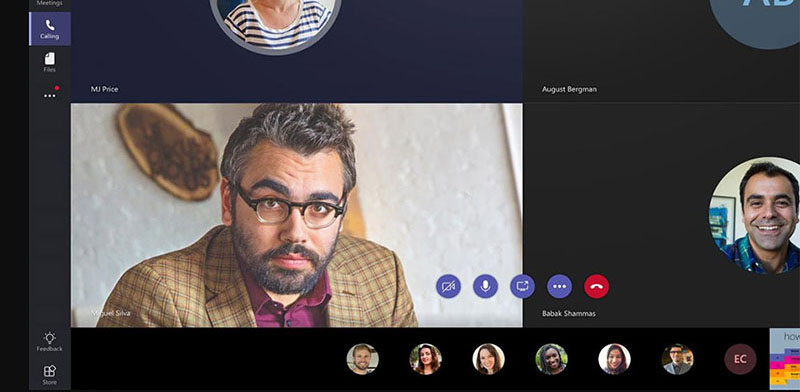How MercuryWorks Works Remotely
Like so many businesses, MercuryWorks has put great energy into grappling with the impacts of COVID-19 shelter-in-place/stay-at-home orders. We needed to quickly and smoothly shift all employees to working from home. This brought work lifestyle changes to the forefront, not the least of which were incorporating family members and often home-schooled kids as part of the “new” workplace.
Add to that the tactical reality of ONLY being able to work with cloud tools and we quickly realized this was a gut check of Mercury’s multi-year cloud and digital enablement strategy. This post is intended to highlight some of the moves, tools and techniques we implemented to work completely remotely.
I hope some of these ideas are useful to you – let me know your thoughts are reactions in the comments below.
Internal Communication and Collaboration

One of our first orders of business as COVID-19 shelter-in-place orders were issued was to ensure the security of each employee. Once we knew that each employee’s personal safety was in place, we needed to be sure that we could keep our employees updated on COVID-19 news, company expectations, updated policies and generally provide a means to communicate and collaborate.
MercuryWorks has used Microsoft 365 (the service formerly known as Office 365) for several years throughout the firm. As Microsoft enhanced its capabilities to be on par with Slack and other modern collaboration tools, our collaboration center of gravity has moved to Teams. With this culture already in place prior to COVID, sticking with our active team chats and automations kept communication and the flow of information clear.
One of the key “cutting the cord” moves Mercury put in place one year ago was to move telephony to the Microsoft 365 cloud. That choice meant that since we have no physical phone circuits routed to any office, we had no telephony equipment to move or redirect as we shut down our main office. MercuryWorks employees chat internally, externally, make and receive phone calls all within the same interface – Teams.
Recording meetings and company all hands meeting within Teams has been key in dealing with the realities of altered work schedules. For employees that aren’t able to attend a meeting they can watch a recording via Stream, obtain key information and contribute via chat asynchronously.
Collaborating with Clients

Very similar to our internal collaboration, Mercury was already using Microsoft 365 and Teams to good effect with clients. From a telephony standpoint, phone calls are routed dynamically to employee devices. If an employee is at their laptop at home that is where client calls are picked up; if an employee is away from their PC/Mac/laptop but on their phone or tablet, that is what rings. File sharing, OneNote sharing and overall chat has been business as usual for our clients as COVID impacts rolled out.
For clients we weren’t already up and running on Microsoft 365, we quickly spun up Teams and onboarded key contacts at each client. Then we started chatting, file sharing, jointly authoring documents and in general keeping up to date on needs and workflow in a relatively trouble-free way.
Conducting Business Without An Office

This is one place where the heat was definitely on as the ability to come into the office and work together came off the table. Historically financials, receipt and issuance of payment, human resource functions and other key business operations were often done at least partially in person. Sometimes paper (!) was even involved. The is where our ability to live the digital cloud life was definitely put to the test.
What we soon found out was how well-poised business processes were already suited to SaaS cloud execution. From moving to the SaaS version of our financial system a few years ago to our cloud-based HR/benefits/performance systems (Zenefits and Lattice), there has been very little impact to our ability to operate the business from home. Online banking portals, supporting business services like DocuSign, Zendesk and Salesforce have been key to keeping business running as usual.
Keeping Applications Up and Running

This is an area where we fully expected to shine – we have been “in the cloud” and specifically operating on the major two clouds (Azure and Amazon Web Services) for several years. In addition we heartily adopted DevOps practices and automation alongside our cloud move. That meant that we did not have to worry about any “servers” tucked under developer desks or specific magical developer laptops to build apps.
Since none of our apps (barring internally-deployed customer apps) run locally or in unmanaged data centers, we lost no insight or control over the assets that run our customers’ apps nor the ability to deploy updates. While cloud provider load definitely grew for healthcare workloads, we saw very few impacts, no knocks to customer app availability/throughput and have been able to build and release at will from home.
Building New Software

In tandem to the use of the Azure and AWS clouds, Mercury runs all of our Agile and DevOps processes through Agile and cloud infrastructure automation platforms. Our main go-to platforms are Azure DevOps and GitLab but ample use of purpose-specific tools like Jira, GitHub and Docker are part of our environment.
Using Git hosted in Azure DevOps to get to code, automate build and release along with test automation and board integration makes for a smooth end-to-end toolchain for our Scrum and DevOps teams. Use of Teams for Scrum team communication and Azure DevOps Boards for sprint planning and standup keeps communication and work planning tight.
I will add that our practice of running test and staging resources in the cloud alongside production systems eliminated a potential “that runs in the office – what we are going to do?” situation for Scrum teams. All compute and storage resources are in the cloud which kept us on a normal course of development business.
Staying Safe and Sane
COVID has brought great importance for employees to take care of themselves. With normal everyday activities disrupted, being very conscious of outside communication and physical activity was important to our entire team. Active cross-team and internal company chats and all hands meetings helped mitigate fear and mental overhead and make sure employees were exercising and healthily fed.
While our employees needed to adapt to different (and sometimes reduced) work schedules because of stay-at-home orders, our Scrum teams adapted to work schedules that fit their new lives. The same has also largely been possible for operations and corporate staff. From time to time we have seen constrained bandwidth from home Internet providers but generally employees have adapted well to our cloud-centered COVID lifestyle.
While COVID-19 and stay-at-home are unprecedented we are operating even better than I had hoped, are being of service to clients and are making sure employees are safe and sane. Strategic use of the cloud and automation are definitely bearing the fruit we expected!
Want to Up Your Firm’s Remote Game?
Let us know about your remote workforce challenges – we can help enable with remote enablement and agility.